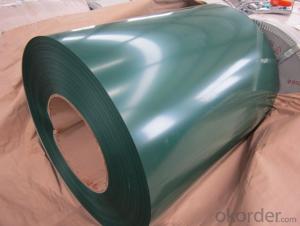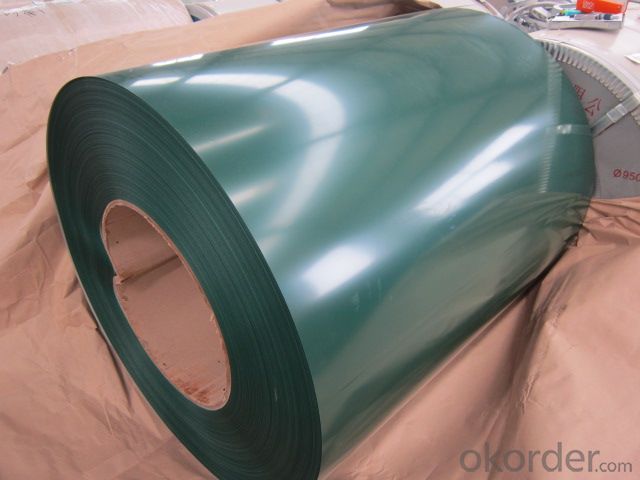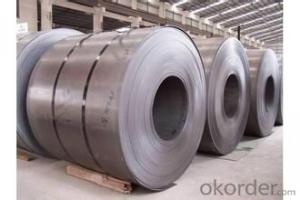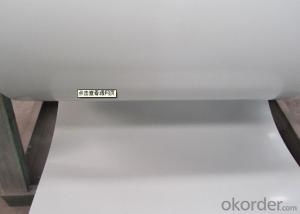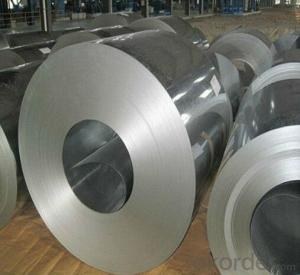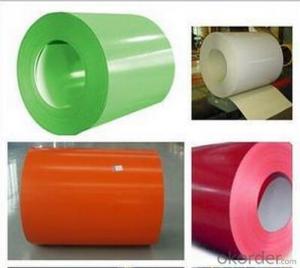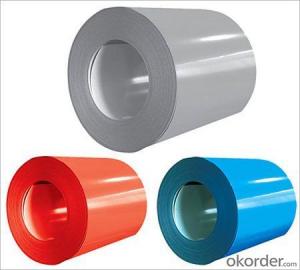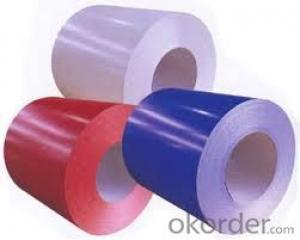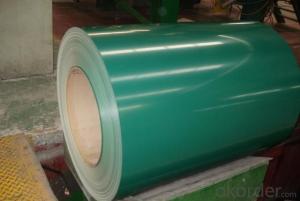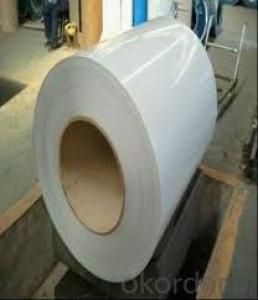Pre-Painted Galvanised Steel Coil in Coils
- Loading Port:
- Shanghai
- Payment Terms:
- TT OR LC
- Min Order Qty:
- 25 m.t.
- Supply Capability:
- 5000 m.t./month
OKorder Service Pledge
OKorder Financial Service
You Might Also Like
Description:
Pre Painted Steel Coil is coated with organic layer, which provides higher anti-corrosion property and a longer lifespan than that of galvanized steel sheets.
The production process has evolved from one-coating-and-one-baking to double-coating-and-double-baking, and even three-coating-and-three-baking.
The base metals for Pre Painted Steel Coil consist of cold rolled, HDG electro-galvanized and hot-dip alu-zinc coated steel. The finish coats of Pre Painted Steel Coil can be classified into groups as follows: polyester, silicon modified polyesters, polyvinylidene fluoride, high-durability polyester, etc.
The Pre Painted Steel Coil can also be classified into groups by their surface textures, namely regular prepainted sheets, embossed sheets and printed sheets.
Application:
Suitable for indoor or outdoor decoration, color lasting for at least 10 years for outdoor using, could for roll forming., conditioning, micro-wave oven, bread maker,solar water heater,condencing apparatus,Blackboard, white board,chalkboard, hidden cell blackboard,bulletin board,Central heating slice, lampshade, chifforobe, desk, bed, locker, bookshelf,garbage can, billboard, typewriter, instrument panel, weight sensor, photographic equipment,coffin, fence, Prepainted Galvanized Steel Coil
Electrical appliance:Refrigerator, washer, switch cabinet, instrument cabinet, air
Product Specification:
Paint: PE or PVDF
Color pre painted steel in coil
Thickness: 0.3-0.8mm
Width: 914-1250mm
Inner Diameter: 508mm,610MM
Weight of Steel Coil: 3-8MT
Available Dipped Layer: 50-150g/m2
Coating Type: Al-Zn Alloy
Available Surface Treatment: Passivating & Oiling & AFP & Filming
Type of coating structure: 2/1 Coat the top surface of the steel sheet twice, coat the bottom surface once, and bake the sheet twice.
Front Side Paint Thickness: 15-25μm
Back Side Paint Thickness: 5-10μm
Standard:JIS G3312,CGCC
FAQ:
1.How about the color of the Pre Painted Steel Coil
The color of the Pre Painted Steel Coil has a very wide selection, like orange, cream-colored, dark sky blue, sea blue, bright red, brick red, ivory white, porcelain blue.
2.Could you tell me the package for the Pre Painted Steel Coil?
Usually Standard export seaworthy package: waterproof paper+steel trip packed+wooden case seaworthy package
3. Can you produce the goods according to the customer’s requirements?
Yes, of course, it can be customized according to customers requirements.
- Q: How are steel coils used in the production of pipes?
- Steel coils are used in the production of pipes by being unwound and then formed into the desired pipe shape through a series of bending, welding, and cutting processes. The steel coils provide the raw material for the pipes and ensure their strength and durability.
- Q: What are the different types of steel coil surface defects?
- There are several different types of steel coil surface defects that can occur during the manufacturing or handling process. Some of the common types include: 1. Rust: Rust is a common surface defect that occurs when the steel coil is exposed to moisture or oxygen. It appears as a reddish-brown discoloration on the surface of the coil. 2. Scratches: Scratches are superficial marks that can occur during handling or transportation of the steel coil. They can vary in depth and severity, ranging from light surface scratches to deep gouges. 3. Stains: Stains are another type of surface defect that can occur due to exposure to chemicals or other substances. They can appear as discolored patches on the surface of the coil, and may be difficult to remove. 4. Roll marks: Roll marks are impressions or indentations that can occur during the rolling process. They are caused by uneven pressure or misalignment of the rolls, and can appear as lines or patterns on the surface of the coil. 5. Edge wave: Edge wave is a defect that occurs when the edges of the coil are not perfectly flat. It can cause the edges to appear wavy or uneven, and may affect the overall appearance and performance of the coil. 6. Oil spots: Oil spots are surface defects that occur when oil or lubricants used in the manufacturing process are not properly removed. They can appear as dark spots or patches on the surface of the coil, and may affect the adhesion of coatings or paints. 7. Pitting: Pitting is a defect that appears as small, shallow depressions or pits on the surface of the coil. It can be caused by factors such as corrosion, uneven cooling, or impurities in the steel. 8. Holes: Holes are more severe surface defects that can occur due to a variety of reasons, such as corrosion, mechanical damage, or manufacturing errors. They can range in size and can significantly affect the structural integrity of the coil. It is important to address these surface defects promptly to ensure the quality and performance of the steel coil. Regular inspections, proper handling, and appropriate surface treatments can help minimize the occurrence of these defects.
- Q: I have a new stainless steel trash compactor under a butcher block counter. We refinished the countertop, but unfortunately the person who did it wasn't careful with the orbital sander and sanded the top edge of the stainless steel compactor door, ruining the finish. The sander marks are not deep - just surface scratches - but they are unsightly. Is there any way to restore the finish to the stainless steel without having to buy a new door?
- Scratches are difficult to remove. Most kitchen appliances, sinks, and counters have a polished finish with short directional polishing lines. Restoring a polished finish to its original appearance requires a professional such as a company that specializes in fabricating or polishing stainless steel. If the refrigerator or dishwasher door panel is replaceable, purchasing a new panel is normally more cost effective than professional refinishing. The homeowner may want to consider obtaining replacement panels with angel hair, distressed, swirl, or embossed finish. These finishes help to hide light scratching and can be obtained from companies that specialize in stainless steel finishes. Counters and appliance doors that are not easily removable must be refinished in place. When the counter is refinished, it may have long rather than short polishing lines. If a slightly different finish is acceptable and cost is a consideration, a homeowner can refinish the counter or appliance using a non-metallic abrasive pad such as a Scotch Brite? pad. This can be done by rubbing the surface with the pad using long uniform strokes in the same direction as the current polishing lines. This will not eliminate deep scratches. A professional may offer this finish as a less expensive option. The resulting finish is normally referred to as a hairline or long grain finish. Some appliance companies are starting to offer this finish.
- Q: What are the different types of steel coil finishes used in architectural applications?
- There are several types of steel coil finishes commonly used in architectural applications. These include mill finish, galvanized finish, painted finish, and stainless steel finish. Mill finish refers to the natural appearance of steel after it has been processed, which typically has a smooth, matte surface. Galvanized finish involves coating the steel with a layer of zinc to provide corrosion resistance. Painted finish involves applying a coat of paint to the steel surface, offering both protection and aesthetic appeal. Lastly, stainless steel finish involves using a steel alloy with a high percentage of chromium, resulting in a shiny and corrosion-resistant surface.
- Q: How are steel coils inspected for color consistency using colorimetry?
- Steel coils can be inspected for color consistency using colorimetry by measuring the color of the surface using a spectrophotometer. This device analyzes the reflected light and provides objective and precise color data. By comparing the color measurements of different areas of the coil, any variations in color consistency can be identified, allowing for quality control and ensuring the desired color uniformity throughout the coil.
- Q: I have several stainless steel utensils and appliances, so when I put them through the dishwasher some of them are rusting, I think its because my current dishwashing soap is harsh, what is some great dishwashing soap that will clean my dishes and not be so hard on my stainless steel appliances and utensils?
- Stainless steel that has screws almost always rusts in the dishwasher. Also semi-complicated stainless steel utensils rust in the dishwasher...things like an egg whisker. This is true no matter what detergent you use. Dishwasher detergent almost always contains bleach. That causes stainless to rust if it has nooks and crannies. The solution? Hand wash them and let them air dry. The only stainless steel I run through the dishwasher is table flatware (knives, spoons, and forks.) You'll get a much longer life out of your utensils if you hand wash them and just let them air dry.
- Q: How are steel coils used in the production of transportation equipment?
- Steel coils are used in the production of transportation equipment, such as automobiles, ships, and trains, to create various structural components. These coils are typically shaped and formed into parts like chassis, frames, bodies, and panels, providing strength, durability, and stability to the vehicles. Additionally, steel coils can be used in the manufacturing of wheels, axles, and suspension systems, ensuring reliable performance and safety in transportation equipment.
- Q: How are steel coils tested for tensile strength?
- Steel coils are typically tested for tensile strength through a process called tension testing, where a sample of the coil is pulled until it breaks. This test measures the maximum amount of force the steel can withstand without breaking, helping to determine its tensile strength.
- Q: Does aluminum or steel hold up better? We found a steel for 1/2 the price of aluminum, obviously its heavier but any other downsides? rust faster ect? also, does anybody know, in PA do you pay sales tax on trailers? and do dealers normally give you license plates to get the trailer home with? we live 3 hours away from the dealer so thats why i want all details :) would stink if i messed up!!
- We have an aluminum trailer over a steel frame. We used to have a steel trailer. There are two differences I see are the weight and how quickly they deteriorate. I personally prefer the aluminum over the steel, the upkeep is easier and they don't weigh as much which equates to fuel savings. Also if you have a lighter truck an aluminum trailer makes the wear and tear a little easier. You can also look at the size of the truck you are going to tow the trailer with, and the size of the horses inside. All together you definately don't want to exceed the weight limits of the truck. Hope this helps...
- Q: How are steel coils tested for dimensional accuracy?
- Steel coils are typically tested for dimensional accuracy using various methods such as measuring the width, thickness, and diameter of the coil. This can be done using specialized instruments like calipers, micrometers, and laser scanners to ensure the coil's dimensions meet the required specifications.
Send your message to us
Pre-Painted Galvanised Steel Coil in Coils
- Loading Port:
- Shanghai
- Payment Terms:
- TT OR LC
- Min Order Qty:
- 25 m.t.
- Supply Capability:
- 5000 m.t./month
OKorder Service Pledge
OKorder Financial Service
Similar products
Hot products
Hot Searches
Related keywords
